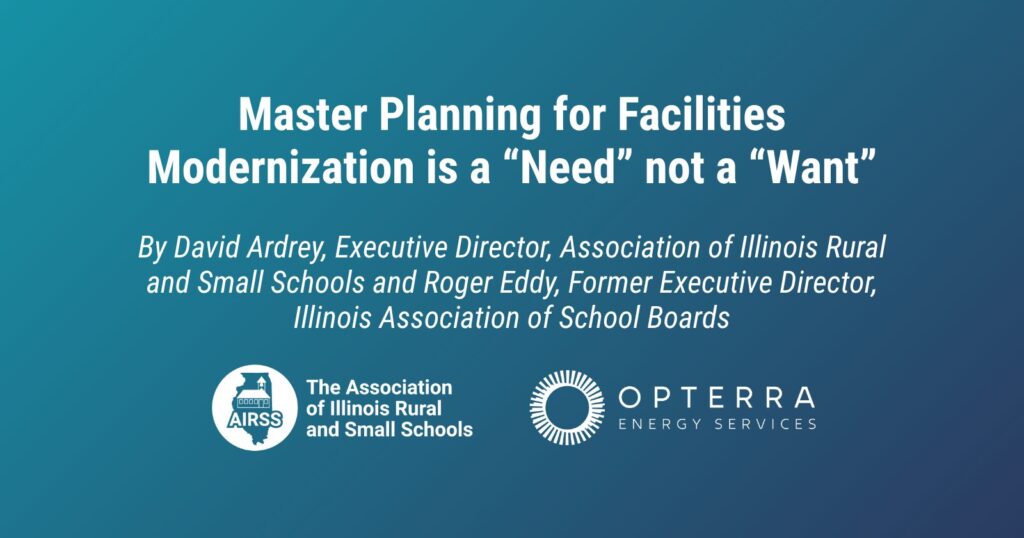By David Ardrey, Executive Director, Association of Illinois Rural and Small Schools and Roger Eddy, Former Executive Director, Illinois Association of School Boards
This article is the final part of a series by AIRSS and OPTERRA Energy Services to explore the coming crisis of rural school infrastructure. Traditional, piecemeal solutions are no longer sufficient to address this issue, and rural schools must move beyond traditional vendor relationships to strategic trusted partnerships. This series provides immediate solutions to this crisis. In this concluding installment, both Ardrey and Eddy restate the case for a new approach to rural school infrastructure planning by underscoring the great risks and rewards facing school administrators on this key issue. Thank you for following AIRSS through this series, and we encourage you to revisit the previous issues in the series discussing the history and approaches of this topic.
Strategic public-private partnerships are not just an option for rural school infrastructure management, but a critical necessity. These partnerships are essential for districts that want to provide 21st-century educational opportunities while maintaining fiscal responsibility and community support.
These partnerships have also proven to be sustainable and adaptable to changing economic conditions, evolving regulatory requirements, and shifting community needs. The relationships that started with basic infrastructure improvements have grown to include strategic planning, grant development, educational programming, and community engagement, far beyond the capabilities of a traditional contractor.
Deferring Decisions is No Longer a Viable Solution
The infrastructure crisis facing rural education is accelerating. Construction costs continue to rise faster than general inflation, skilled labor shortages are intensifying, and regulatory requirements are becoming more complex. Districts that continue to defer infrastructure decisions or rely on traditional vendor relationships will face exponentially higher costs and increasingly limited options for addressing their facility needs.
Initiative-taking infrastructure management is essential for community sustainability. High-quality educational facilities serve as economic development anchors that support business retention, population stability, and property values. Conversely, districts that fail to maintain competitive educational environments risk accelerating community decline through reduced property values, business relocations, and population loss.
Furthermore, federal and state funding opportunities available today may not be available forever. Rural districts must act strategically to access these resources while they are available, rather than waiting for future opportunities that may never materialize.
Embracing Implementation with Reduced Risk and Burden to the District
Rural superintendents and school boards should begin their partnership evaluation process by conducting comprehensive needs assessments. These assessments should prioritize health and safety requirements, regulatory compliance needs, and opportunities for operational efficiency that can be funded through savings and incentive programs.
When selecting a partner, districts should prioritize rural education expertise, a long-term commitment to the relationship, financial stability, and a proven ability to navigate public sector procurement requirements. Partners should also demonstrate an understanding of rural community dynamics, local workforce development priorities, and opportunities to integrate educational programming.
Financial structuring should maximize available grant and incentive programs while providing guaranteed savings that offset infrastructure investments over time. Districts must resist the temptation to choose the lowest initial cost over long-term value creation and operational benefits.
Finally, board governance frameworks should provide strategic oversight and avoid micromanagement that undermines the partnership’s effectiveness. Board members should focus on performance monitoring, community communication, and policy development rather than getting involved in technical implementation details.
Call to Action: Partnering Approach to Take Rural Education into the Future
Rural education leaders face a clear choice: continue managing infrastructure reactively through traditional vendor relationships, which increases costs and limits options, or embrace strategic partnerships. These partnerships provide no-cost access to expertise, resources, and opportunities typically only available to large urban and suburban districts.
The evidence shows that districts choosing the partnership path can achieve comprehensive facility modernization while building community confidence, enhancing educational programming, and strengthening local economic development. These districts are better positioned to compete for talent, resources, and opportunities in an increasingly challenging educational and financial environment.
Rural students deserve educational environments equal to their urban and suburban counterparts. Rural communities deserve schools that are a source of pride and economic development, not symbols of decline and disinvestment. Strategic partnerships offer a pathway to achieving these objectives while honoring the traditions of local control and community engagement that make rural education unique.
The time for incremental improvements and deferred decisions is over. Rural education leaders must act strategically, boldly, and collaboratively to ensure their districts provide the educational opportunities and community leadership that rural America needs for continued prosperity and growth. The future of rural education depends on leaders who see these partnerships as an opportunity for collaboration and vision, not a compromise or a limitation. The evidence is clear: districts that embrace this new approach will thrive, while those that cling to traditional methods will face increasingly difficult challenges and limited opportunities for success.
In September, the AIRSS, representing more than 500 member districts, announced its Premier Annual Sponsorship with OPTERRA – Partnering to Power Progress Across Rural and Small Schools. This partnership is designed to bring unprecedented support to rural and small schools by addressing critical infrastructure and facilities needs while reducing financial and operational barriers for school leaders. For more information, please visit the Resources for Facilities and Infrastructure Renewal.
About the Authors:
Roger Eddy brings over four decades of experience as an educator and administrator at all levels from PreK to Community College. In addition to being a rural educator, Eddy served five terms in the Illinois House of Representatives and was Executive Director of the Illinois Association of School Boards.
Dave Ardrey has served over a decade as Executive Director of the AIRSS, and has served as the President and Interim Executive Director of the National Rural Education Association. Additionally, Ardrey directs School Partnerships and Outreach at Southern Illinois University Carbondale and was the Founding Chair of the Rural Schools Collaborative.

